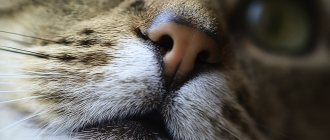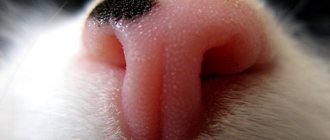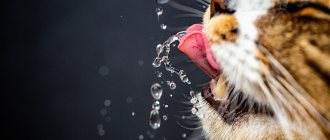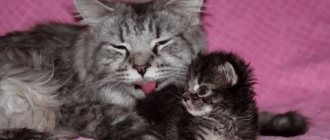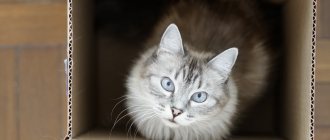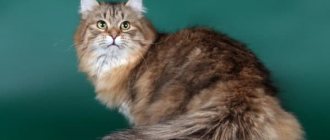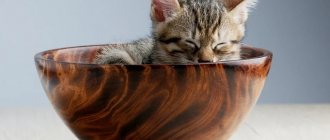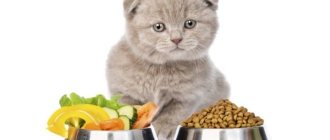Cats have long been pets that need care and attention from their owners. This also applies to diet. The pet owner is responsible for what the cat will eat today, tomorrow, and the day after tomorrow. Her health and a proper, balanced diet depend on the person. Many people prefer ready-made food, in which professionals have taken into account all the needs of the cat’s body at different periods of its life. Premium cat food always contains beet pulp. What about animals that eat natural food? Maybe beets are not at all necessary in a cat’s diet and can be replaced with other products?
Features of feeding cats
Cat owners who refuse industrial food for their pet in favor of “natural” food often make the same mistake. They believe that meat and fish are enough for normal nutrition. At the same time, the main argument they give is that in nature cats practically do not consume plant foods.
But the absence of vegetables in the diet of wild carnivores does not mean that it is not sufficiently balanced. Cats devour any prey they catch whole. And it is from there that they take the necessary substances for their body, for example:
- calcium is obtained from scales, wool or bones;
- the supplier of carbohydrates is the contents of the stomachs of rodents and birds;
- proteins and fats are obtained by eating muscle tissue;
- The source of vitamins is plants.
Under natural conditions, an animal will always find where to get the element missing for its body. Domestic cats are deprived of this, and their health depends only on the owner. Therefore, it is important to ensure that your furry pet receives a sufficient amount of vitamins. Vegetables or sprouted grass are the source of nutrients. One of the essential vegetables for cats is beets.
Diet planning
One adult animal weighing about 4 kg needs about 200 grams of natural food per day.
For castrated males or female cats, this rate should be reduced, since due to changes in the functioning of hormones, metabolic processes slow down. As a result, the animal may become obese. The general percentage composition of the correct diet for a cat is as follows:
- 70% protein foods (raw or boiled beef, poultry, rabbit).
- 20% raw or boiled vegetables.
- 10% boiled porridge.
The basis of the food is meat. This is an indispensable product that allows the animal to be healthy, gain energy and have beautiful skin and coat.
Meat contains those amino acids that are extremely necessary for the animal and are not found anywhere else, namely:
- Biotin (essential for healthy skin and coat).
- Taurine (found only in fish and beef, responsible for the health of blood vessels, nervous and reproductive systems).
- Arginine (responsible for metabolic processes in the body and the production of hormones).
It is important to remember that cooking meat destroys these amino acids. Also, fats and proteins enter the cat’s body with animal products.
They participate in the structure of body cells and are the main supplier of energy for an active cat.
Also, fats and proteins enter the cat’s body with animal products. They participate in the structure of body cells and are the main supplier of energy for an active cat.
Fish is also a good supplier of protein and rare amino acids, but it is not recommended to give it more than once every few weeks, and it is completely prohibited for castrated cats. This is due to the fact that this product contributes to the appearance of urolithiasis in cats.
In addition to these products, fermented milk products (kefir, fermented baked milk, cottage cheese) and eggs (only boiled or raw yolk) can be added to the cat’s diet.
(adsbygoogle = window.adsbygoogle || []).push({});
In addition to meat, a healthy animal needs vegetables. It is an indispensable supplier of fiber and vitamins. Vegetables normalize the functioning of the gastrointestinal tract, and can be either raw or boiled. You can add to your daily diet: carrots, cabbage, sweet potatoes, spinach.
In last place are cereal crops. This could be boiled rice, oatmeal, or corn kernels. They are added to food in the form of a ground paste.
Composition and beneficial properties of the vegetable
The red root vegetable contains an unusually rich range of useful substances. It includes:
- Organic acids (acetic, oxalic, tartaric, malic).
- Vitamins (almost the entire group B, C, P, PP, carotene).
- Minerals (cobalt, phosphorus, magnesium, copper, calcium and especially potassium).
- Amino acids (lysine, arginine, histidine, valine).
- Glucose, sucrose and fructose.
In addition, beets contain pantothenic and oleanolic acids, iodine and little-known methylmethionine sulfonium chloride, or vitamin U. The vegetable is also a supplier of fiber, proteins and carbohydrates.
Thanks to its beneficial composition, beets can improve many physiological processes in the cat’s body.
Effect on the body. When introduced into the diet, the root vegetable helps:
- normalization of hormonal levels;
- hemoglobin production and blood thinning;
- formation of a strong skeleton;
- increasing immunity;
- strengthening the walls of blood vessels;
- lowering cholesterol;
- normalization of gastric juice acidity.
In addition, beets help reduce the risk of tumors and allergic reactions, take part in lipid metabolism, maintain energy balance and prevent the development of anemia.
What's good about strawberries?
In strawberries, however, we find quite a few valuable ingredients. Will they be good for the cat?
- Antioxidants. They are found in the skin and pulp of strawberries. Antioxidants are often praised as a natural way to prevent human disease. However, scientists are not sure that they are also beneficial for animals. For cats, salmon will be a more reliable source of antioxidants.
- Water. The fruit has a lot of water. Since cats rarely drink, strawberries can provide an additional source of hydration.
- Manganese. Cats need this enzyme in small quantities. This is more necessary for kittens that are still growing. However, each special kitten product contains the correct amount of this ingredient and no additional additives are required.
- Folic acid (vitamin B9). Strawberries are rich in folic acid, which aids digestion. This vitamin can help with heartburn and stomach problems. Cats get folic acid mainly from grass, which they like to chew on. Strawberries can replace it from time to time.
- Potassium. As an electrolyte, potassium is essential for cats. In particular, older cats may have low blood potassium levels. Strawberries may be a natural supplement in this regard. However, consider this fruit as a small potassium supplement rather than a major source.
The biggest advantage of strawberries and strawberries is that they do not contain harmful and toxic substances that can cause direct harm to our pet. Consumption of strawberries is considered safe for cats. If you have a super original cat who loves to eat it, then be careful so that he doesn’t overeat it.
How to properly feed cats beets
In order for your pet to get the maximum benefit from eating beets, it is important to follow the rules for preparing them:
- To feed cats, you need to choose fresh root vegetables. They should not be lethargic, have no traces of mold or foreign odors.
- Before cooking, be sure to rinse the vegetable in warm water.
- You need to cook the beets over high heat for no more than half an hour. If you increase the cooking time, there will be nothing useful left in it.
- It is strictly forbidden to add salt and spices to the cooking water.
- To prevent the accumulation of nitrates in the beets, be sure to drain the water after cooking.
- Store beets for cat food only in the refrigerator, no more than a day.
Submission rules and regulations. Before giving the root vegetable to your pet, it should be cut into small pieces. It is recommended to give beets raw in the form of puree or juice. For feeding cats, preference should be given only to table beet varieties.
The approximate norm in combination with other vegetables is 30-40 g, but no more than 10% of the daily diet and no more than 2 times a week.
Kittens begin to be introduced to beetroot complementary foods from 3 months of age. Along with the root vegetable, you can use finely chopped beet tops. You can only combine beets with other vegetables or meat. It is forbidden to give fermented milk products at the same time as this vegetable.
Human food: can it be given?
It would seem that it could be easier than feeding a domestic cat with dishes from your table. But, before you treat your little friend to a fragrant cutlet fried in a frying pan, borscht, a delicious salad or ordinary porridge with spices, think about what awaits your cat in a few years, or even months.
The fact is that such food is absolutely not suitable for feeding a pet. Most dishes are prepared according to traditional recipes: fry, cook fatty broths, be sure to add salt and other spices to enhance the taste. All this together is real poison for a cat! She, of course, will be happy to enjoy a well-fried fish or a delicious sweet dessert, but we will now tell you what consequences to expect from such a diet!
Why you shouldn't eat certain foods:
- canned, spicy, fried and salty foods greatly irritate the gastric mucosa, which soon leads to indigestion and other gastrointestinal pathologies;
- smoked meats, sausages, sausages, boiled pork and other gastronomic meat products contain too high a percentage of salt and spices, which complicates the functioning of the kidneys and heart, and also leads to the development of cardiovascular diseases;
- There are no enzymes in the cat's body that break down sugar, so they should never be given sweets in any form, which can cause obesity and dental health problems;
- bones, especially small fish and chicken bones, can injure the throat and mucous membranes of the digestive organs, cause internal bleeding and other adverse complications that are dangerous to the life and health of the cat;
- raw fish and raw meat in an unprocessed form - high risks of parasitic infection;
- fatty dairy products worsen the functioning of the intestines and other digestive organs, contributing to the development of obesity.
Despite the list of contraindications, the diet of domestic cats should be varied and fortified. Due to a lack of vitamins and other useful elements in the animal’s body, very unfavorable diseases can also occur that shorten the life span.
So, if you are wondering what to feed your cat at home, do not consider food from your table as an option. Only separately prepared meals or ready-made industrial food, which greatly simplifies the feeding regimen of the animal.
When to use beets with caution
In addition to its beneficial effects, beets can also have harmful effects on your pet’s body. The urine of a healthy cat is acidic, and with constant consumption of red vegetables, its acidity is significantly reduced. This can lead to various problems, including:
- the formation of salt crystals (uroliths) in the urinary tract;
- irritation, swelling or capillary bleeding of the urethra;
- obstruction (blockage) of the urinary canal.
If there is complete obstruction, the animal may die within 3 days.
Other adverse effects. Frequent feeding of beets increases blood sugar levels. These fast carbohydrates can cause diabetes. In addition, the root vegetable contains iron. If the vegetable is consumed excessively, it can accumulate in the body and cause problems with the pancreas. It is also known that beets have a laxative effect, which can lead to digestive problems in the animal.
Are there any contraindications?
Fodder or sugar beets can be fed to chickens in strictly limited quantities. The daily requirement for crushed feed is only 30-50 grams per head. Exceeding the dosage can lead to diarrhea or depression in chickens. In this case, laying hens are stopped feeding these products. True, it will not be possible to do without such valuable and cheap food.
It's better to take a short break and watch the birds. Perhaps the diarrhea was caused by some other food. After all, all large poultry farms feed chickens fodder or sugar beets in huge quantities.
After some time, you can resume feeding the birds with this food. True, instead of fresh, it is better to give chickens boiled root vegetables. The taste of vegetables will only improve after heat treatment. Boiled root vegetables have a lesser laxative effect; this product does not irritate the intestinal receptors, therefore, in case of intolerance, fresh vegetables can be replaced with boiled ones at any time.
Mr. Cat Recommends: Effective Home Remedies
In case of constipation, there is no need to immediately stuff your animal with medications. Sometimes they are necessary, but most often you can get by with effective and safe folk remedies.
Here are some good recipes:
- Condensed milk. Condensed milk is mixed with clean water in a ratio of 1:3, and given to the cat in small quantities (no more than a tablespoon) several times a day. The time interval between laxative doses should be at least three hours, and in total the laxative should be given no more than five times a day. Diabetes mellitus is a contraindication to the use of this method.
- Vegetable oils (coke, linseed, olive). A few drops of oil should be added to the animal's food. You can’t overdo it; you should give no more than a quarter of a teaspoon. This method can only be used in extreme cases, when no other laxatives are available. Vegetable oils have a negative effect on the cat’s liver and can cause discomfort and negative reactions from the intestines. Veterinarians do not recommend using oils as a laxative. Only adult animals can be treated in this way.
- Vaseline oil, castor oil. These agents help move stool through the intestines. Vaseline or castor oil should be given to your cat using a special syringe. It is best to discuss dosages with your veterinarian. The optimal dose is calculated based on the weight of the animal (about 1.5 ml per kilogram of weight). After taking such a laxative, it is necessary to limit the cat's food intake. It is advisable not to give anything before bowel movement. Usually, defecation occurs after 3-5 hours. If there is no effect during this time, you need to repeat taking the product.
- Milk. For cats, the whole product has a laxative effect. Warm milk is given in small quantities, several times a day. You cannot overdo it with this remedy, as an overdose can cause severe diarrhea.
- Freshly squeezed vegetable juices and raw vegetables. As a laxative, you can give your pet a few pieces of beets, pumpkin or carrots, as well as juice from these vegetables.
If there are plants in the house, or the cat walks outside, then, following instinct, it can pick up a laxative for itself. Plants with a laxative effect:
- cat mint;
- Melissa;
- rhubarb leaves;
- aloe;
- pharmaceutical camomile;
- buckthorn;
- cucumber leaves;
- centaury.
You can prepare a decoction from these plants and give your cat water several times a day. It is better to make it one-component, taking a tablespoon of any herb per glass of boiling water. After standing, cooling and straining the product, it should be given to the animal 1-2 teaspoons every 3-4 hours.
In addition to oral remedies, there are other methods to combat constipation. The most effective and fastest way to alleviate a cat’s condition is a cleansing enema.
It is advisable that the procedure be performed by a veterinarian or nurse.
If the owner has some experience, he can give his pet an enema himself. To carry out the procedure, take warm water or chamomile decoction. It is necessary to monitor the temperature of the liquid so as not to cause pain or discomfort to the cat.
Another way to stimulate intestinal peristalsis so that it is freed from feces is abdominal massage. Only the owner can do it, since cats really do not like touching the most vulnerable part of the body from their point of view. You should calm the cat down, and then slowly stroke it, without pressing too hard, in a clockwise circular motion. The massage procedure is carried out after taking a laxative.
Disadvantages of plasma therapy
As you can see, PRP therapy has an impressive number of benefits.
However, there are also disadvantages that are important to consider before deciding on plasma injections. The disadvantages are:
The disadvantages are:
- Swelling and bruising at injection sites. This is a consequence characteristic of many procedures that prolong youth. But, as a rule, all traces disappear within a few days. However, if the patient has sensitive skin, bruising and redness may last longer.
- There may be soreness. Generally, people with a low pain threshold may experience discomfort during the procedure.
- One procedure will not give a lasting effect - a course of procedures is necessary. Their number is prescribed by the doctor.
- On older faces the effect will not be convincing. The most pleasant results are usually obtained by patients aged 30-40 years.
- The procedure should only be performed by an experienced doctor who follows all the rules of anesthesia and blood preparation. Otherwise, infection and complications may occur.
- Quite a high cost of the procedure. Despite the fact that no drugs are used during plasma rejuvenation, the price for manipulation is no lower than for numerous “beauty injections”.
- The patient may be disappointed with the result. True, in the event that he violates the training rules.
Despite some disadvantages, PRP therapy is an effective and safe procedure that is gaining popularity. Many patients note that their face becomes smoother, firmer and more rested. Rashes disappear and wrinkles become less pronounced. At the same time, the skin stops peeling and glows with health.
But it must be taken into account that plasma therapy will not be able to transform a patient who ignores the preparation rules. And it’s not just about observing dietary restrictions. It is advisable to undergo tests before the procedure, which will “tell” about the person’s current state of health. The doctor will advise which ones after consultation.
And, of course, it is important to find a competent doctor who can choose the optimal treatment strategy.
Raw or cooked
The opinions of felinologists and veterinarians differ, but there are no strict prohibitions regarding either fresh or boiled vegetables. Cats are reluctant to eat them, so owners often follow the pet’s taste and give them in the form that he likes. Be sure to cook food for animals with diseases of the gastrointestinal tract.
The need for treatment for healthy cats depends on the stiffness of the fibers:
- beets , cabbage , pumpkin are boiled to soften coarse fiber and reduce the concentration of nitrates;
- tomatoes , potatoes , eggplants are processed to remove solanine;
- greens and cucumbers are given raw;
- zucchini , green beans , and carrots are fed fresh and boiled.
Plant food is a secondary but necessary component of a cat’s diet. They are taught to eat them from childhood, they are given vegetables that the pet eats, except toxic ones, and they are prepared correctly.
If it gets bad
To prevent beets from harming your pet, you must carefully monitor the feeding rate. An adult dog needs 20 grams of raw or boiled beets 1-2 times a week. Introduce complementary foods carefully, observing the reaction.
If the animal becomes ill after eating beets, then it is necessary to seek help from a veterinarian. The reasons may be:
- individual intolerance;
- allergy;
- violation of complementary feeding norms;
- pancreatitis and others.
Symptoms of poisoning:
- vomit;
- diarrhea;
- thirst;
- lethargic state;
- refusal to eat;
- in rare cases, spasms.
The first aid that must be provided to the animal is gastric lavage and an enema. After this, give any absorbent, for example, activated carbon.
Where the pain is felt
The structure of the pancreas will help to understand why pain can radiate to other parts of the body. This organ weighs about 70–80 g. It contains a head, body and tail. In an adult, this organ grows in length to 14–22 cm. The width of the gland in the head is 3–9 cm. Its structure is extremely complex: it contains many ducts, alveoli, ganglia, nerves and vessels. The main function of this organ is the production of vital enzymes, secretions and hormones.
The pain can be felt in the upper abdomen and seems to come from deep within. It often radiates to the left shoulder and back, and sometimes encircles. The nature of the pain can be gnawing, aching or tearing.
Different breeds
Due to its composition, beets are suitable for almost all breeds of dogs. Only Dalmatians cannot tolerate it. The only trouble that a vegetable can cause is a change in color in those with white fur. With excessive consumption of beets, the coat turns yellow or takes on a sandy tint in the following breeds:
- chihuahua;
- poodle;
- Maltese;
- Bichon Frize;
- Clumber Spaniel;
- silky windhound;
- white Spitz (Pomeranian or Japanese);
- Samoyed dog;
- West Highland White Terrier.
